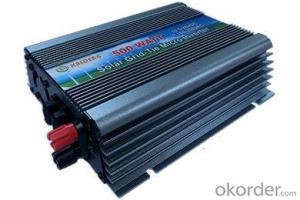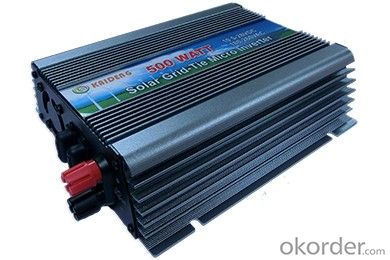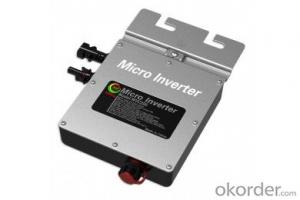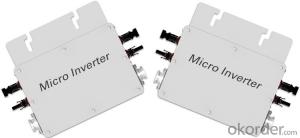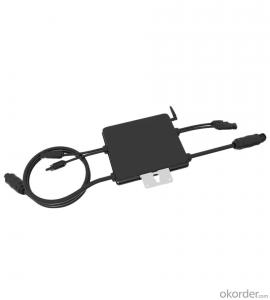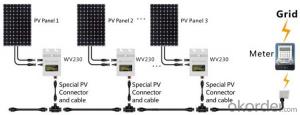24V MPPT Solar Inverter - KD-GTI500W Series Micro Inverter, Hot Sales
- Loading Port:
- China main port
- Payment Terms:
- TT OR LC
- Min Order Qty:
- 1000 pc
- Supply Capability:
- 100000 pc/month
OKorder Service Pledge
OKorder Financial Service
You Might Also Like
Structure
The transition from a centralized to a distributed inverter optimizes energy collection.
The converter module integrated into the solar panels can reduce installation costs.
Soft switch technology to replace hard-switching technology can improve efficiency and reduce heat dissipation.
From cottage industry to mass production, standardized design (hardware and software) to improve reliability and reduce costs.
Using a special capacitor (due to the high failure rate). Design requires a higher voltage to reduce the current, we use a special electrolytic capacitors.
The converter can be connected to the grid to eliminate the need for many battery applications. The high price of batteries, require maintenance, life expectancy is shorter.
Work required micro-inverter power increasingly smaller (only a few hundred watts), which can reduce the internal temperature and improve reliability.
Micro-inverter solar inverter system needs to deal with a lot of a particular power level, in order to increase production, thereby reducing costs.
DC input voltage range:10.5-28VDC
AC output voltage range:80-160VAC/180-260VAC
AC output power :500Wp
AC frequency range:50Hz/60Hz
G.W.:1.8kg
Size:315mm*188mm*85mm
KD-GTI500W Series Using IP67 waterproof streamline design, Can effectively prevent rainwater on the surface erosion, Built-in high-performance Maximum Power Point Tracking(MPPT)Function,Better able to track changes in the solar luminosity and control different output power, Effectively capture and collect sunlight. AC electric power transmission using the reverse transmission technology, Is one of our patented technology, The inverter output power can provide load priority use, Extra electricity to the grid, Efficient use of the inverter to the power emitted, Electricity transmission rate of up to 99%.
Features
Pure Sine Wave Output;
High performance Maximum Power Point Tracking(MPPT);
Power Automatically Locked(APL);
Reverse power transmission;
High-Frequency High Conversion Rate;
Anti-Islanding Protect;
Input /output is fully isolated to protect the electrical safety;
Multiple parallel stacking;
The Leading Patent Technology;
IP65 WaterProof;
Flexible Installation;
Simplify maintenance (user serviceable)
High Efficiency & Best Cost-Effectiveness
Images
Specification
Grid-series models | 300W | 500W | 800W | 1000W |
Recommend use solar panels | 420Wp | 620Wp | 1050Wp | 1250Wp |
DC Maximum Input Power | 400W | 600W | 900W | 1200W |
DC maximum voltage | VpvDC30.2VDC | |||
DC voltage range | Vpv 10.5V~28VDC | |||
Maximum output power factor | 99% | |||
Maximum input current | 20A | 30A | 45A | 65A |
AC output power | 300W | 500W | 800W | 1000W |
AC maximum output power | 300W | 500W | 800W | 1000W |
Anti-voltage protection | Fuse | |||
AC standard voltage range | 90~160VAC/190~262VAC | |||
AC frequency range | 55Hz~63Hz/ 45Hz-53Hz | |||
THDI | <5% | |||
Phase | <1% | |||
Islanding protection | VAC;f AC | |||
Output short circuit protection | Current-limiting | |||
Show | LED | |||
Installation | Wall hanging | |||
Cooling | Fan | |||
Standby Power | <2W | |||
Night Power | <1W | |||
Ambient temperature range | -25 °C~60°C | |||
Humidity | 0~99%(Indoor Type Design) | |||
Waterproof | Indoor Type Design | |||
Electromagnetic Compatibility | EN50081.part1 EN50082.part1 | |||
Power System Disturbance | EN61000-3-2 EN60950-1 | |||
Network test | DIN VDE 1026 | |||
Certificate | CE | |||
FAQ
Can we visit your factory?
Surely, I will arrange the trip basing on your business schedule.
Can you do OEM for us?
Yes, we can.
How do you pack your products?
We have rich experience on how to pack the panels to make sure the safety on shipment when it arrives at the destination.
Can you help us install the module if we cooperate with you?
We haven’t entered into installation sector, but we have the plan in near future.
- Q: How do you connect a solar inverter to a data monitoring system?
- To connect a solar inverter to a data monitoring system, you need to follow a few steps. First, ensure that your inverter is compatible with the data monitoring system you intend to use. Then, connect the inverter to your local network using an Ethernet cable or wireless connection. Next, access the inverter's settings through a web interface or mobile app and enable data monitoring. Finally, input the necessary information, such as IP addresses or log-in credentials, into the data monitoring system to establish the connection between the inverter and the monitoring platform.
- Q: What is the expected lifespan of a solar inverter?
- The expected lifespan of a solar inverter can vary depending on several factors such as the quality of the equipment, usage patterns, and maintenance. On average, a well-maintained solar inverter can last between 10 to 15 years. However, some high-quality inverters have been known to last up to 20 years or more. Regular maintenance and monitoring can help prolong the lifespan of the inverter and ensure optimal performance throughout its lifespan.
- Q: Can a solar inverter work without batteries?
- Yes, a solar inverter can work without batteries. In a grid-tied solar system, the inverter converts the DC power generated by the solar panels into AC power, which can be used to power appliances or fed back into the utility grid. Batteries are typically used in off-grid systems to store excess energy for later use, but they are not necessary for the basic function of a solar inverter.
- Q: How does MPPT improve the performance of a solar inverter?
- MPPT (Maximum Power Point Tracking) improves the performance of a solar inverter by optimizing the power generated from the solar panels. It continuously adjusts the operating voltage and current to ensure that the solar panels are operating at their maximum power point, which is the point where they generate the most power. This allows the solar inverter to convert the maximum amount of solar energy into usable electricity, resulting in increased efficiency and improved overall performance.
- Q: How does a solar inverter handle voltage regulation during sudden load changes?
- A solar inverter handles voltage regulation during sudden load changes by continuously monitoring the voltage and current outputs from the solar panels. When there is a sudden increase or decrease in the load, the inverter adjusts its power output accordingly to maintain a stable and consistent voltage level. This is achieved through a combination of control algorithms and power electronics within the inverter, ensuring that the voltage remains within an acceptable range to meet the demands of the load.
- Q: What is the role of power ramp rate control in a solar inverter?
- The role of power ramp rate control in a solar inverter is to regulate the rate at which the power output of the solar system increases or decreases. This control is important to ensure the stability and reliability of the grid, as sudden changes in power generation can cause disruptions. By gradually ramping up or down the power output, the solar inverter can respond to grid conditions and prevent overloading or underutilization of the system, ultimately improving the overall performance and efficiency of the solar installation.
- Q: How is a solar inverter connected to the solar panels?
- A solar inverter is connected to solar panels through a direct current (DC) input from the panels, which is then converted into alternating current (AC) output by the inverter.
- Q: Can a solar inverter be used with a solar-powered data center?
- Yes, a solar inverter can be used with a solar-powered data center. A solar inverter is responsible for converting the direct current (DC) generated by solar panels into alternating current (AC) that can be used to power electrical devices. In the case of a solar-powered data center, the solar inverter would play a crucial role in converting the DC electricity produced by the solar panels into AC electricity that can be used to power the data center's servers, cooling systems, and other equipment.
- Q: What is the temperature range for optimal operation of a solar inverter?
- The temperature range for optimal operation of a solar inverter typically falls between 0°C (32°F) to 40°C (104°F).
- Q: Can a solar inverter be used with different types of solar PV systems (roof-mounted, ground-mounted, etc.)?
- Yes, a solar inverter can be used with different types of solar PV systems, including roof-mounted and ground-mounted systems. Solar inverters are designed to convert the DC (direct current) electricity generated by solar panels into AC (alternating current) electricity that can be used in homes or fed back into the grid. Regardless of the installation type, the solar inverter's function remains the same.
Send your message to us
24V MPPT Solar Inverter - KD-GTI500W Series Micro Inverter, Hot Sales
- Loading Port:
- China main port
- Payment Terms:
- TT OR LC
- Min Order Qty:
- 1000 pc
- Supply Capability:
- 100000 pc/month
OKorder Service Pledge
OKorder Financial Service
Similar products
Hot products
Hot Searches
Related keywords
